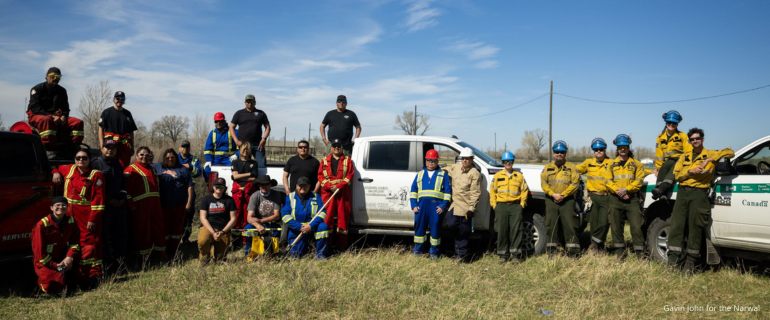This reflection draws from a recent piece in The Narwhal (SpearChief-Morris, 2025), which celebrates the resurgence of cultural fire practices on the Blood Tribe (Kainai) territory in Southern Alberta, marking a pivotal moment in a growing partnership with Natural Resources Canada.
Overgrown prairie grasses, invasive plants, and eroding river banks: this is the land outside the pow wow arbour on the Blood Tribe reserve. However, this story now includes fire as a tool for traditional landscape restoration, embracing cultural burning practices for the first time in decades.
Rooted in Blackfoot tradition, ceremony, and Indigenous-land stewardship, cultural burning represents a bold act of regeneration and a rekindling of cultural knowledge that has been long suppressed. While both prescribed and cultural burns are controlled, intentional fires, that help manage landscapes, restore ecosystems, and reduce the risk of devastating wildfires, that is where many similarities end.
So, what’s the Difference?
Cultural burning is fundamentally different from what we’ve come to know as a prescribed burn. Using a western scientific approach, prescribed burns are often designed and implemented by government wildlife agencies. They are often technical, mechanized operations that use drip torches, intended to prevent wildfires and enhance ecological wellbeing (not for culturally-significant reasons).
Cultural burns, by contrast, are deeply relational, rooted in Indigenous-land management practices and knowledge, and are often ceremonial. They follow traditional teachings passed down through generations, not just to restore the land, but to also restore relationships with the land, with each other, and with ancestral cultural heritage. In lighting the first fire with dried cattails and prayer, Kainai Elders Calvin Williams and Dennis Chief Calf, revived a practice that colonial policies had long criminalized.
Fire, Reconciliation, and Rematriation
For Alvin First Rider, Kainai Nation’s environmental manager, cultural fire is part of a larger “living restoration project.” Not only is this an act of landscape tending and care, but it is also about reclaiming sovereignty, reintroducing not just fire, but bison, beavers, and the knowledge systems that sustained the prairies for thousands of years.
This return to fire also represents a return to responsibility. In traditional Blackfoot stories, fire is a sacred and respected tool that must be used wisely. After generations of fire suppression, fear, and disconnection, cultural burns also promote generational cultural healing, not just as an act of reconciliation with Canada’s colonial past, but also with the land itself.
However one of the most powerful aspects of the cultural burn in the Blood Tribe territory was the sense of community it brought together. Fire guardians worked together along with Elders, youth, and visitors from across the Blackfoot Confederacy, representing a significant act of regeneration of the landscape, language, relationships, responsibilities, and cultural identity.
Reclaiming Fire in an Era of Environmental Crises
This burn marks only the beginning of reintroducing historical practices. First Rider and the Kainai Fire Guardians are committed to advancing this work as a powerful expression of sovereignty and culture, with plans to lead new fire knowledge exchanges, plant willow to restore stream banks, and ultimately invite the return of beavers and bison populations to the land.
This story is a vision of rematriation, illustrating a return of life to land, balance to ecosystems, and of people to their cultural heritage in their role as land stewards. At a time when extreme weather events, notably wildfires, are becoming more destructive and frequent, we are reminded by these Indigenous knowledge keepers that cultural suppression is the problem, not fire, and that the cost of suppression has caused generations-worth of damage ecologically, culturally, and spiritually.
Written by Sabrina Careri, for Ann Dale.
 Image Source: Gavin John | The Narwhal
Image Source: Gavin John | The Narwhal